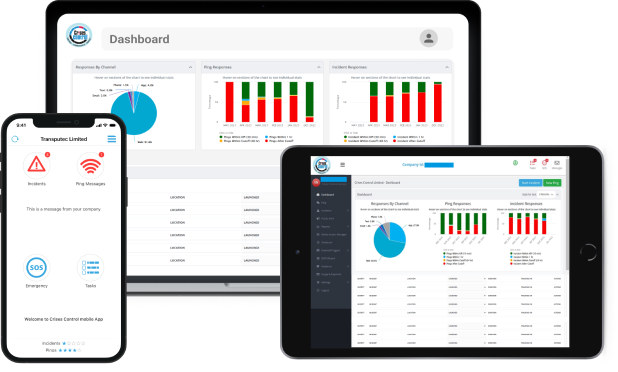Written by Asipe Nokenke | Marketing Assistant
You’ve created a business continuity plan. It’s detailed, aligned to risk frameworks, and ticks all the right boxes. But then something actually happens.
Your payment system goes down. Deliveries stall. The office loses power. Teams look around, waiting for instructions. And that carefully crafted plan? No one can find it. No one knows what to do next.
This is the reality for too many organisations, not because they didn’t plan, but because their plan wasn’t built for real-time action. It sat in a file, disconnected from people and day-to-day operations.
That’s where emergency communication tools make all the difference. They don’t replace your continuity strategy, they make it operational.
Why Continuity Plans Don’t Always Deliver
Business continuity planning is essential. But having a plan on paper doesn’t guarantee you’ll weather a crisis. Most business continuity plans fail not because they’re flawed, but because they’re missing key ingredients.
These are the patterns we see repeatedly:
- Plans are static: The document exists, but it’s not integrated into the tools your teams actually use.
- Execution is unclear: Roles aren’t assigned. The “who does what” gets figured out on the fly.
- Communication is ad hoc: Teams rely on emails, calls, or WhatsApp messages to coordinate under pressure.
- No real-time visibility: Leaders can’t tell who’s seen the plan, what’s been actioned, or where the gaps are.
Even well-designed plans fall apart when they’re not linked to fast, structured communication. That breakdown is where downtime, financial loss, and reputational damage creep in.
What Business Continuity Looks Like When It Works
Let’s say a supplier outage delays fulfillment across three of your major regions. You’ve got customers waiting, sales teams confused, and no immediate answers.
In a business using manual processes, the response might look like this:
- An email is drafted, sent to “All Staff.”
- Key updates are relayed through line managers
- Sales reps ask for a statement they can send to clients
- IT is unsure whether to escalate internally or wait
- Leadership receives piecemeal updates by phone or chat
Now compare that to an organisation using Crises Control:
- The incident response is triggered directly from the platform
- Alerts are sent instantly across mobile, email, SMS, desktop, and voice
- Teams receive tailored instructions, not generic messages
- Pre-built workflows are activated automatically
- Dashboards with live response tracking show who’s responded, what’s been done, and what still needs attention
In one version, people guess and scramble. On the other hand, they act with clarity and purpose.
This is what effective business continuity execution looks like in the real world.
Why Communication Is the Missing Link in Most Continuity Plans
A continuity plan isn’t a script. It’s a strategy. But in the middle of a disruption, what people need isn’t more detail, it’s direction.
They need to know:
- What’s happening
- What they’re expected to do
- What others are already doing
- How can they be kept informed
That’s the gap emergency communication tools like Crises Control fill. They turn static instructions into structured, timely action, tailored to the right people, across the right channels, with confirmation of delivery and response.
Turning Business Continuity from Theory into Action
Here’s how the right communication platform supports your response in practice:
Instant Activation: Your team can initiate a response on any device using mobile-first alerts and pre-approved workflows, no digging for PDFs or calling emergency meetings.
Tailored Messaging: Different teams need different instructions. Crises Control lets you segment alerts so operations, customer support, IT, and HR each get exactly what they need to know.
Live Oversight: Real-time dashboards give leadership visibility into who has responded, what’s been escalated, and where bottlenecks are forming, all as it happens.
Audit-Ready Records: Every alert, response, and escalation is time-stamped and logged. This creates a verifiable audit trail for post-incident reviews, insurers, or regulators.
What’s Actually at Stake When Continuity Plans Fail
When business continuity plans fail, the real damage goes far beyond system downtime. It shakes confidence in your team, your leadership, and your brand.
Here’s what’s really at risk:
- Customers start questioning your reliability
- Employees feel unsure and unsupported
- Stakeholders worry about business resilience
- Regulators want proof that risks are being properly managed
The impact of a failed response is often longer and more damaging than the incident itself. That’s why crisis management software and structured communications should be embedded in your continuity approach from day one.
Why Business Continuity Plans Fail During Real Emergencies
In theory, your business continuity plan covers everything. But in reality:
- Staff panic or forget what they were taught
- Documents go unread or can’t be found
- People send conflicting instructions
- Key players are unreachable
- Escalation chains break under pressure
None of that means your planning was wrong. It means your planning wasn’t activated properly.
Tools like Crises Control are designed specifically to fill that gap when real-life conditions test your ability to respond. When communication flows clearly, people stay aligned, and execution improves dramatically.
Avoiding the Most Common Mistakes
Even the best strategy can fail without the right tools and habits. Here’s what to watch out for:
Waiting until it’s too late to test: You don’t want your first run-through to be the real thing. Schedule quarterly drills, stress test your tools, and evaluate performance regularly.
Assuming everyone knows their role: Roles must be clearly assigned, documented, and regularly reviewed. Don’t expect people to remember procedures from six months ago.
Relying on one channel of communication: People miss emails. Systems crash. Relying on a single method increases your risk. Use layered channels like SMS, mobile app alerts, voice calls, and push notifications.
Ignoring remote or hybrid workers: Out of sight shouldn’t mean out of sync. Ensure all your people, whether they’re in the office or halfway across the world, receive the same timely updates.
Not logging what happens: Manual notes or memory won’t hold up in a review. You need accurate logs of who was alerted, who responded, and when action was taken.
Conclusion: From Planning to Preparedness
A well-written business continuity plan is a great first step. But plans alone don’t protect people or performance. Execution does.
And execution only works when your teams can communicate, coordinate, and act fast, clearly, and confidently.
That’s where Crises Control fits in. It gives you the tools to bridge the gap between theory and reality, from paper to people.
Want to see how it works for your organisation?
Request your free personalised demo today and find out how Crises Control brings business continuity planning to life when it matters most.
Request a FREE Demo

